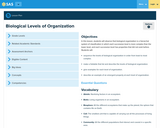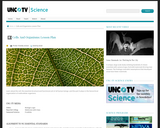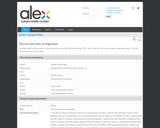
This parent guide supports parents in helping their child at home with the 7th grade Science content.
- Subject:
- Science
- Material Type:
- Reference Material
- Vocabulary
- Author:
- Kelly Rawlston
- Letoria Lewis
- Date Added:
- 10/11/2022

This parent guide supports parents in helping their child at home with the 7th grade Science content.

This resource accompanies our Rethink 7th Grade Science course. It includes ideas for use, ways to support exceptional children, ways to extend learning, digital resources and tools, tips for supporting English Language Learners and students with visual and hearing impairments. There are also ideas for offline learning.

Students will observe that biological organization is a hierarchial system of classification in which each successive level is more complex than the lower level, and each successive level has properties that did not exist before. Students will sequence the levels of organization and make a foldable that lists and describes the levels.

This video discusses cells and compares and contrasts eukaryotic and prokaryotic cells.

This video discusses cells and compares and contrasts eukaryotic and prokaryotic cells.

This resource is a collection of pictures that students will look at and determine the level of cellular organization.

With this resource students will learn about higher order of organization.

This resource explains that all living things are organized into several basic levels of organization

This resource is a collection of vocabulary words related to cell structures.

In this lesson, students will list the major organelles of animal and plant cells and describe their functions. Students will also summarize the hierarchical organization of multicellular organisms from cells to tissues, organs, systems, and organisms.

In this lesson, students create a model that is analogous to a cell. They will use a predetermined model to associate cell function to structure and will discuss the limitations of the models used in the investigation. They will communicate their work and then evaluate the work of their peers in a given context.

Students will learn how climate change poses risks to human health. Students will realize we need to safeguard our communities by protecting people’s health and quality of life from climate change impacts. Students will apply what they have learned and discuss in groups how the U.S. could apply their research and support toward third world countries. The standards tagged are for the entire series of lessons as a whole. This lesson was developed by Marty Ervin as part of their completion of the North Carolina Global Educator Digital Badge program. This lesson plan has been vetted at the local and state level for standards alignment, Global Education focus, and content accuracy.

Students will learn how climate change poses risks to human health. Students will realize we need to safeguard our communities by protecting people’s health and quality of life from climate change impacts. The standards tagged are for the entire series of lessons as a whole. This lesson was developed by Marty Ervin as part of their completion of the North Carolina Global Educator Digital Badge program. This lesson plan has been vetted at the local and state level for standards alignment, Global Education focus, and content accuracy.

Students will understand how climate change can affect human health and how some populations will be especially affected. Students will investigate different countries of the world and how these countries contribute to air pollution and global warming. The standards tagged are for the entire series of lessons as a whole. This lesson was developed by Marty Ervin as part of their completion of the North Carolina Global Educator Digital Badge program. This lesson plan has been vetted at the local and state level for standards alignment, Global Education focus, and content accuracy.

Students will consider multiple perspectives of other cultures and countries. They will realize that global warming may not be a priority in countries where the basic population is struggling to maintain an existence. Students will understand how difficult it is to insure all countries of the world reduce their contribution to global warming and follow the lead of the United States. Students will create a proposed action plan for how they will act and educate others on the impact on human health of global warming. Students will apply their knowledge and discoveries from this unit to propose how they teach others about the importance of reducing their own carbon footprint. The standards tagged are for the entire series of lessons as a whole. This lesson was developed by Marty Ervin as part of their completion of the North Carolina Global Educator Digital Badge program. This lesson plan has been vetted at the local and state level for standards alignment, Global Education focus, and content accuracy.

Students will create two models of the digestive system and determine the correct placement of various organs of the digestive system. Students will use the model to compare mechanical and chemical digestion. Students will use information provided by the model to explain why food spends various amounts of time in a particular organ. To extend the learning of this module, students will design an experiment to determine the effect of introducing new foods to a baby's diet. The module also includes a presentation, a word search puzzle, and a bingo game emphasizing vocabulary words related to the digestive tract.

In this inquiry investigation, students will use microscopes to observe slides of unknown tissues representative of the major groups found in the human body and then draw their observations in a science notebook. They will then work in groups to develop unique classification schemes for the tissues that are presented to the class.

Students will read a passage, write to answer questions about the passage, and write to justify an response to an opinion question. This resource supports English language development for English language learners.

THis TED Talk video summarizes biological organization from a single cell to the biosphere of Earth.

In this lesson, students will create models of the digestive system and use a marble to show the path food takes through the system.